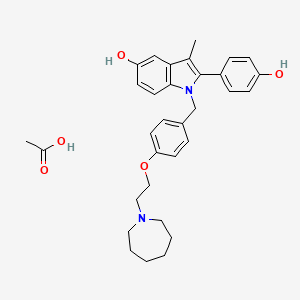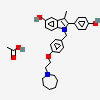Bazedoxifene acetate
- Bazedoxifene acetate
- 198481-33-3
- Viviant
- Bazedoxifene (acetate)
- WAY-140424
- Create:2005-08-08
- Modify:2025-01-18
 Bazedoxifene (annotation moved to); Oestrogens conjugated, bazedoxifene (annotation moved to).
Bazedoxifene (annotation moved to); Oestrogens conjugated, bazedoxifene (annotation moved to).
- bazedoxifene
- bazedoxifene acetate
- TSE 424
- TSE-424
- TSE424
- WAY-140424
- Bazedoxifene acetate
- 198481-33-3
- Viviant
- Bazedoxifene (acetate)
- WAY-140424
- Conbriza
- Duavive
- Bazedoxifen acetate
- TSE 424
- DTXSID3048657
- J70472UD3D
- 198481-33-3 (acetate)
- TSE424
- 1H-Indol-5-ol, 1-[[4-[2-(hexahydro-1H-azepin-1-yl)ethoxy]phenyl]methyl]-2-(4-hydroxyphenyl)-3-methyl-, acetate (1:1)
- NCGC00182055-02
- Bazedoxifene Acetate
- Viviant (TN)
- 1-(4-(2-(azepan-1-yl)ethoxy)benzyl)-2-(4-hydroxyphenyl)-3-methyl-1H-indol-5-ol acetate
- 1-(p-(2-(Hexahydro-1H-azepin-1-yl)ethoxy)benzyl)-2-(p-hydroxyphenyl)-3-methylindol-5-ol monoacetate (salt)
- 1H-Indol-5-ol, 1-((4-(2-(hexahydro-1H-azepin-1-yl)ethoxy)phenyl)methyl)-2-(4-hydroxyphenyl)-3-methyl-, monoacetate (salt)
- DTXCID0028583
- 1-(p-(2-(Hexahydro-1H-azepin-1-yl)ethoxy)benzyl)-2-(p-hydroxyphenyl)-3-methylindol-5-ol acetic acid
- acetic acid;1-[[4-[2-(azepan-1-yl)ethoxy]phenyl]methyl]-2-(4-hydroxyphenyl)-3-methylindol-5-ol
- CAS-198481-33-3
- Brilence
- WAY-TES 424
- UNII-J70472UD3D
- Bazedoxifene Acetate [USAN]
- Bazedoxifene acetate [USAN:JAN]
- 1H-Indol-5-ol, 1-[[4-[2-(hexahydro-1H-azepin-1-yl)ethoxy]phenyl]methyl]-2-(4-hydroxyphenyl)-3-methyl-, acetate (1:1); 1H-Indol-5-ol, 1-[[4-[2-(hexahydro-1H-azepin-1-yl)ethoxy]phenyl]methyl]-2-(4-hydroxyphenyl)-3-methyl-, monoacetate (salt) (9CI); Bazedoxifene acetate; TSE 424; Viviant; WAY-TES 424
- MFCD09260074
- Bazedoxifene-Acetate?
- 1-[[4-[2-(Hexahydro-1H-azepin-1-yl)ethoxy]phenyl]methyl]-2-(4-hydroxyphenyl)-3-methyl-1H-indol-5-ol Acetate
- SCHEMBL635726
- CHEMBL2106615
- HY-A0036R
- BAZEDOXIFENE ACETATE [MI]
- Bazedoxifene acetate (JAN/USAN)
- OMZAMQFQZMUNTP-UHFFFAOYSA-N
- Bazedoxifene (acetate) (Standard)
- BAZEDOXIFENE ACETATE [JAN]
- BAZEDOXIFENE ACETATE [USAN]
- BCP19656
- EX-A5414
- HY-A0036
- TSE 424;WAY-TES 424
- Tox21_113013
- BAZEDOXIFENE ACETATE [MART.]
- s2167
- BAZEDOXIFENE ACETATE [WHO-DD]
- AKOS015896590
- Tox21_113013_1
- CCG-269916
- NCGC00182055-03
- AS-19563
- BAZEDOXIFENE ACETATE [ORANGE BOOK]
- D03062
- Q27281282
- 1-(4-(2-(azepan-1-yl)ethoxy)benzyl)-2-(4-hydroxyphenyl)-3-methyl-1H-indol-5-olacetate
- 1-(p-(2-(Hexahydro-1H-azepin-1-yl)ethoxy)benzyl)-2-(p-hydroxyphenyl)-3-methylindol-5-ol monoacetate (salt)
- 1-{4-[2-(azepan-1-yl)ethoxy]benzyl}-2-(4-hydroxyphenyl)-3-methyl-1H-indol-5-ol acetate (1:1)
- 1H-Indol-5-ol, 1-((4-(2-(hexahydro-1H-azepin-1-yl)ethoxy)phenyl)methyl)-2-(4-hydroxyphenyl)-3-methyl-, monoacetate (salt)
Bazedoxifene (annotation moved to)
- Oestrogens conjugated, bazedoxifene (annotation moved to)


H361 (93.8%): Suspected of damaging fertility or the unborn child [Warning Reproductive toxicity]
H410 (93.8%): Very toxic to aquatic life with long lasting effects [Warning Hazardous to the aquatic environment, long-term hazard]
P203, P273, P280, P318, P391, P405, and P501
(The corresponding statement to each P-code can be found at the GHS Classification page.)
Aggregated GHS information provided per 32 reports by companies from 4 notifications to the ECHA C&L Inventory. Each notification may be associated with multiple companies.
Information may vary between notifications depending on impurities, additives, and other factors. The percentage value in parenthesis indicates the notified classification ratio from companies that provide hazard codes. Only hazard codes with percentage values above 10% are shown.
Repr. 2 (93.8%)
Aquatic Chronic 1 (93.8%)
Patents are available for this chemical structure:
https://patentscope.wipo.int/search/en/result.jsf?inchikey=OMZAMQFQZMUNTP-UHFFFAOYSA-N
- CAS Common ChemistryLICENSEThe data from CAS Common Chemistry is provided under a CC-BY-NC 4.0 license, unless otherwise stated.https://creativecommons.org/licenses/by-nc/4.0/Bazedoxifene acetatehttps://commonchemistry.cas.org/detail?cas_rn=198481-33-3
- ChemIDplusBazedoxifene acetate [USAN:JAN]https://pubchem.ncbi.nlm.nih.gov/substance/?source=chemidplus&sourceid=0198481333ChemIDplus Chemical Information Classificationhttps://pubchem.ncbi.nlm.nih.gov/source/ChemIDplus
- EPA DSSToxBazedoxifene acetatehttps://comptox.epa.gov/dashboard/DTXSID3048657CompTox Chemicals Dashboard Chemical Listshttps://comptox.epa.gov/dashboard/chemical-lists/
- European Chemicals Agency (ECHA)LICENSEUse of the information, documents and data from the ECHA website is subject to the terms and conditions of this Legal Notice, and subject to other binding limitations provided for under applicable law, the information, documents and data made available on the ECHA website may be reproduced, distributed and/or used, totally or in part, for non-commercial purposes provided that ECHA is acknowledged as the source: "Source: European Chemicals Agency, http://echa.europa.eu/". Such acknowledgement must be included in each copy of the material. ECHA permits and encourages organisations and individuals to create links to the ECHA website under the following cumulative conditions: Links can only be made to webpages that provide a link to the Legal Notice page.https://echa.europa.eu/web/guest/legal-notice1-(4-[2-(azepan-1-yl)ethoxy]benzyl)-2-(4-hydroxyphenyl)-3-methyl-1H-indol-5-olhttps://echa.europa.eu/substance-information/-/substanceinfo/100.166.4311-(4-[2-(azepan-1-yl)ethoxy]benzyl)-2-(4-hydroxyphenyl)-3-methyl-1H-indol-5-ol (EC: 638-804-4)https://echa.europa.eu/information-on-chemicals/cl-inventory-database/-/discli/details/171265
- FDA Global Substance Registration System (GSRS)LICENSEUnless otherwise noted, the contents of the FDA website (www.fda.gov), both text and graphics, are not copyrighted. They are in the public domain and may be republished, reprinted and otherwise used freely by anyone without the need to obtain permission from FDA. Credit to the U.S. Food and Drug Administration as the source is appreciated but not required.https://www.fda.gov/about-fda/about-website/website-policies#linkingBAZEDOXIFENE ACETATEhttps://gsrs.ncats.nih.gov/ginas/app/beta/substances/J70472UD3D
- ChEMBLLICENSEAccess to the web interface of ChEMBL is made under the EBI's Terms of Use (http://www.ebi.ac.uk/Information/termsofuse.html). The ChEMBL data is made available on a Creative Commons Attribution-Share Alike 3.0 Unported License (http://creativecommons.org/licenses/by-sa/3.0/).http://www.ebi.ac.uk/Information/termsofuse.htmlChEMBL Protein Target Treehttps://www.ebi.ac.uk/chembl/g/#browse/targets
- ClinicalTrials.govLICENSEThe ClinicalTrials.gov data carry an international copyright outside the United States and its Territories or Possessions. Some ClinicalTrials.gov data may be subject to the copyright of third parties; you should consult these entities for any additional terms of use.https://clinicaltrials.gov/ct2/about-site/terms-conditions#Use
- Comparative Toxicogenomics Database (CTD)LICENSEIt is to be used only for research and educational purposes. Any reproduction or use for commercial purpose is prohibited without the prior express written permission of NC State University.http://ctdbase.org/about/legal.jsp
- Drug Gene Interaction database (DGIdb)LICENSEThe data used in DGIdb is all open access and where possible made available as raw data dumps in the downloads section.http://www.dgidb.org/downloadsBAZEDOXIFENE ACETATEhttps://www.dgidb.org/drugs/rxcui:1442171
- Open TargetsLICENSEDatasets generated by the Open Targets Platform are freely available for download.https://platform-docs.opentargets.org/licenceBAZEDOXIFENE ACETATEhttps://platform.opentargets.org/drug/CHEMBL2106615
- DailyMed
- Drugs@FDALICENSEUnless otherwise noted, the contents of the FDA website (www.fda.gov), both text and graphics, are not copyrighted. They are in the public domain and may be republished, reprinted and otherwise used freely by anyone without the need to obtain permission from FDA. Credit to the U.S. Food and Drug Administration as the source is appreciated but not required.https://www.fda.gov/about-fda/about-website/website-policies#linkingBAZEDOXIFENE ACETATEhttps://www.accessdata.fda.gov/scripts/cder/daf/
- European Medicines Agency (EMA)LICENSEInformation on the European Medicines Agency's (EMA) website is subject to a disclaimer and copyright and limited reproduction notices.https://www.ema.europa.eu/en/about-us/legal-noticeConbriza (EMEA/H/C/000913)https://www.ema.europa.eu/en/medicines/human/EPAR/conbriza
- EU Clinical Trials Register
- FDA Orange BookLICENSEUnless otherwise noted, the contents of the FDA website (www.fda.gov), both text and graphics, are not copyrighted. They are in the public domain and may be republished, reprinted and otherwise used freely by anyone without the need to obtain permission from FDA. Credit to the U.S. Food and Drug Administration as the source is appreciated but not required.https://www.fda.gov/about-fda/about-website/website-policies#linking
- KEGGLICENSEAcademic users may freely use the KEGG website. Non-academic use of KEGG generally requires a commercial licensehttps://www.kegg.jp/kegg/legal.htmlTherapeutic category of drugs in Japanhttp://www.genome.jp/kegg-bin/get_htext?br08301.kegAnatomical Therapeutic Chemical (ATC) classificationhttp://www.genome.jp/kegg-bin/get_htext?br08303.kegTarget-based classification of drugshttp://www.genome.jp/kegg-bin/get_htext?br08310.keg
- National Drug Code (NDC) DirectoryLICENSEUnless otherwise noted, the contents of the FDA website (www.fda.gov), both text and graphics, are not copyrighted. They are in the public domain and may be republished, reprinted and otherwise used freely by anyone without the need to obtain permission from FDA. Credit to the U.S. Food and Drug Administration as the source is appreciated but not required.https://www.fda.gov/about-fda/about-website/website-policies#linking
- NCI Thesaurus (NCIt)LICENSEUnless otherwise indicated, all text within NCI products is free of copyright and may be reused without our permission. Credit the National Cancer Institute as the source.https://www.cancer.gov/policies/copyright-reuseNCI Thesaurushttps://ncit.nci.nih.gov
- NIPH Clinical Trials Search of Japan
- NLM RxNorm TerminologyLICENSEThe RxNorm Terminology is created by the National Library of Medicine (NLM) and is in the public domain and may be republished, reprinted and otherwise used freely by anyone without the need to obtain permission from NLM. Credit to the U.S. National Library of Medicine as the source is appreciated but not required. The full RxNorm dataset requires a free license.https://www.nlm.nih.gov/research/umls/rxnorm/docs/termsofservice.htmlbazedoxifene acetatehttps://rxnav.nlm.nih.gov/id/rxnorm/1442171
- Springer Nature
- Wikidatabazedoxifene acetatehttps://www.wikidata.org/wiki/Q27281282
- PubChem
- Medical Subject Headings (MeSH)LICENSEWorks produced by the U.S. government are not subject to copyright protection in the United States. Any such works found on National Library of Medicine (NLM) Web sites may be freely used or reproduced without permission in the U.S.https://www.nlm.nih.gov/copyright.htmlbazedoxifenehttps://www.ncbi.nlm.nih.gov/mesh/67447119Selective Estrogen Receptor Modulatorshttps://www.ncbi.nlm.nih.gov/mesh/68020845Bone Density Conservation Agentshttps://www.ncbi.nlm.nih.gov/mesh/68050071
- GHS Classification (UNECE)GHS Classification Treehttp://www.unece.org/trans/danger/publi/ghs/ghs_welcome_e.html
- MolGenieMolGenie Organic Chemistry Ontologyhttps://github.com/MolGenie/ontology/
- PATENTSCOPE (WIPO)SID 389464802https://pubchem.ncbi.nlm.nih.gov/substance/389464802
- NCBI


 CID 176 (Acetic Acid)
CID 176 (Acetic Acid)